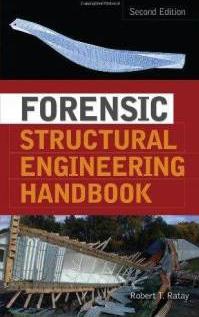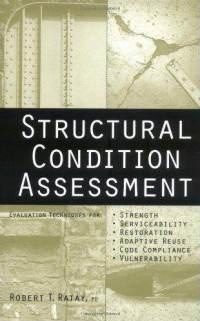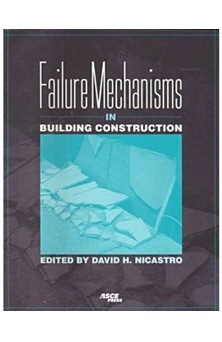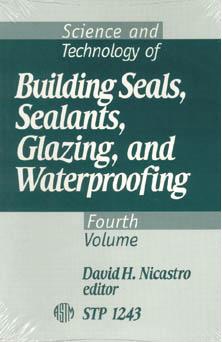
FORENSIC STRUCTURAL ENGINEERING HANDBOOK, 2ND EDITION

STRUCTURAL CONDITION ASSESSMENT

FAILURE MECHANISMS IN BUILDING CONSTRUCTION by David H. Nicastro, P.E.
- Comprehensive catalog of failure mechanisms, with causes and characteristics, and a tabular index.
- Case histories on everything from structural collapses to water infiltration.
- Annotated bibliography on forensic engineering, including sources for further information on each of the failure mechanisms discussed.
- Glossary of forensic engineering terms.

SCIENCE AND TECHNOLOGY OF BUILDING SEALS, SEALANTS, GLAZING AND WATERPROOFING, David H. Nicastro, P.E., Editor, 4th Volume
- Joint Design and Sealant Selection
- Joint Sealant Failures: Case Studies and Methods of Evaluation
- Structural Silicone Glazing (SSG):Design, Evaluations, and Applications
- Aesthetic Performance of Sealants
- Advances in Adhesion Testing and Adhesive Promoters
- Studies Related to the Long-Term Performance and Aging of Sealants and Gaskets.
Articles
Copies of the following articles may be purchased from the listed publishers.

Ensuring Durable Performance of CFRP-strengthened Concrete
by Roya A. Abyaneh, EIT, and Edward S. Breeze, PE
The Construction Specifier, June 2018

Defining and testing construction tape and flashing durability
by Anthony M. Garcia, PE, and Jorge M. Blanco
December 14, 2017
Construction tapes and flashings are used to span joints and gaps, typically in conjunction with a primary water-resistive barrier (WRB) or air barrier. Since they are concealed behind cladding, it is important tapes and flashings are durable. Will they remain adhered in harsh conditions? Can they accommodate movement for the design life of the building? This article’s authors performed hundreds of tests to evaluate different tape adhesive chemistries and durability on a variety of substrates.

Durability of elastomeric sealants
by David H. Nicastro, PE, and Beth Anne Feero, EIT
February 25, 2015
Sealant is used in the exterior joints of every modern building, but usually incorrectly. Owners have high expectations for performance and durability, but premature sealant failure is common, resulting in air and water infiltration, property damage, and expensive repair work. Design details and installation practices contribute to the service life, but there is a bigger problem in the industry—many sealant products cannot resist movement and weathering, which are their core functions.

Durability of water-resistive barriers
by Beth Anne Feero, EIT and David H. Nicastro, PE
January 29, 2015

Bearing pad durability in precast concrete garages
by Doris Eichburg, Beth Anne Feero, EIT, and David Nicastro, PE
January 7, 2015

Durable Waterproofing for Concrete Masonry Walls: Field testing methods of water repellency
by Robert M. Chamra, EIT and Beth Anne Feero, EIT
June 24, 2014

Durability of Brick Veneer: A deeper look at masonry anchors
by Brett T. Fagan, PE, Nickie M. Ramm, PE, and Beth Anne Feero, EIT
January 17, 2014

Ensuring Balcony Durability: Waterproofing details that stand the test of time
by David H. Nicastro, PE, and Marie Horan, PE
November 30, 2013

Investigating Sheathing Durability: Infrared surveys in hot climates
by Brett T. Fagan, PE, and Adrian Gerard Saldanha
October 2, 2013
Sheathing decay caused by trapped water in building walls is a leading cause of construction damage. Unfortunately, because sheathing is concealed after construction, this only becomes evident after consequential distress develops in the structure or finishes.

Testing the Test: Water absorption with RILEM tubes
by Adrian Gerard Saldanha and Doris E. Eichburg
August 9, 2013
Water repellents are often applied to exterior walls to reduce absorption. A common question from building owners is, “When does the repellent need to be re-applied?” Since water repellents are clear, visual inspections are not useful to evaluate their durability. A simple field test frequently used to measure the effectiveness of water repellents is the RILEM tube. But is this widely used test reliable?

Ensuring Durability of Elastomeric Wall Coatings: Strong recommendations for better standards
by David H. Nicastro, PE, F.ASTM, and Patrick D. Gorman
July 12, 2013
Durability of exterior coatings is usually considered as a function of weathering, but an elastomeric wall coating (EWC) may fail long before environmental exposure can cause deterioration. As the name implies, these products are selected for their ability to stretch, especially over a crack in the substrate. If the crack propagates through the coating, the system can fail during its first year of service.

Understanding why doors leak
by Adrian Gerard Saldanha and David H. Nicastro, PE
May 1, 2013
Leaking exterior doors are a common problem affecting building owners and tenants, causing property damage, and requiring expensive repairs. Designers and builders are aware of the issue. Nevertheless, they continually struggle to prevent water infiltration through this fundamental building element.

Improving stucco durability using moist-curing
January 6, 2013
by Nickie Ramm, EIT
Observations of numerous building envelope failures in stucco (i.e. portland cement plaster) indicate it may lack durability when correct installation practices are not performed. One of the most common problems is cracked stucco—and with the increasing trend of using the material as a cladding, the situation will likely get worse.
- “Durability of Horizontal Sealant Joints,” (with Patrick D. Gorman) ASTM Special Technical Publication No. 1453, 2004.
- “Structural Defect Discovered During Roof Replacement”, James McCue and David Nicastro, Journal of Performance of Constructed Facilities, ASCE, May 2003; www.asce.org
- “Evaluation and Repair of Post-Tensioned Concrete Structures”, David Nicastro and Terry Campion, The Construction Specifier, November 1999; www.csinet.org
- “Sealing Horizontal Joints Subject to Water and Foot Traffic”, David Nicastro, The Construction Specifier, September 1999; www.csinet.org
- “The Engineer’s Role”, Foundations Column, David Nicastro, The Construction Specifier, October 1997; www.csinet.org
- “Monitoring and Incentive Payments”, David Nicastro, The Construction Specifier, June 1997; www.csinet.org
- “Premature Sealant Failure”, David Nicastro, The Construction Specifier, April 1997; www.csinet.org
- “Difficult Sealant Joints”, David Nicastro, in ASTM STP No. 1200, 1992; www.astm.org
- “Water Vapor Transmission”, The Construction Specifier, June 1991; www.csinet.org
- “A Scientific Approach to Water Infiltration Studies”, The Construction Specifier, January 1991; www.csinet.org
- “Common Problems in Masonry Detailing”, The Construction Specifier, September 1989; www.csinet.org
- “Parameters for Comparing High Performance Sealants”, The Construction Specifier, April 1989; www.csinet.org
- “Uncovering the Reasons for Curtain Wall Failure”, Exteriors Magazine, Summer 1988; [NOT IN PRINT]
- “Can Engineers Cut Curtain Wall Failures?”, Civil Engineering Magazine, November 1993; www.asce.org
Monthly “Failures” Columns
From January 1994 through August 1997, David Nicastro published the monthly column “Failures” in The Construction Specifier. Single copies of each column may be purchased from www.csinet.org.

